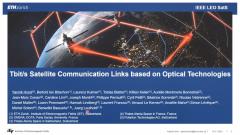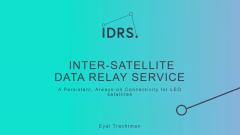
This video program is a part of the Premium packages:
Performance Analysis of 5G Networks: New Directions
- IEEE MemberUS $1.00
- Society MemberUS $0.00
- IEEE Student MemberUS $1.00
- Non-IEEE MemberUS $2.00
- IEEE MemberUS $50.00
- Society MemberUS $0.00
- IEEE Student MemberUS $25.00
- Non-IEEE MemberUS $100.00
Performance Analysis of 5G Networks: New Directions
Future wireless networks like 5G will carry an increasingly wide variety of data traffic, with different QoS requirements. In addition to conventional data traffic generated from HTTP, FTP and video streaming applications by mobile broadband users (human-type communication (HTC) traffic), traffic from machine-to-machine (M2M) and Internet-of-Things (IoT) applications (machine-type communication (MTC) traffic) has to be supported by 5G networks. Some of these data applications are sensitive to delay (live-video, IoT in medical application etc.), while others (FTP, e-mail, smart-metering etc.) are not. HTC traffic at the base station is characterized by two stages of randomness:(i) at the macro level, the arrival processes of service requests of different types of service (ii) at the micro level, the rate of packet generation of the service type, the size of these packets and their servicing times (waiting time + transmission time). The macro level arrival process (i.e. connection-level) is non-stationary, depending on the temporal dynamics of service usage. The length of data session in HTC traffic is random, thereby the number of packets generated in any given interval of time is random. In MTC traffic, randomness in traffic arises from random number of devices trying to connect to the base station at any given time. Packets generated by devices may be either periodic or event-triggered, and number of packets generated is small. Estimating time-dependent aggregate traffic from all types of traffic and the delay experienced by each traffic type is critical in designing 5G access networks that ensure the stipulated QoS requirements of each traffic type. Nevertheless, it is difficult to model aggregate traffic due to the time-dependent arrival rate of human-type and machine-type traffic. In this tutorial, special correlation functions of stochastic point processes called Product Densities (PDs) are used for estimating time-dependent aggregate traffic and delay in both types of traffic, as seen by the base station. For HTC traffic, PDs are defined for evaluating offered load under time-dependent connection arrival rates (macro level) and for estimating the expected number of ON periods in an interval of time
(0,T)(0,T) (micro level). For MTC traffic, PDs are defined for estimating the random number of devices connected to the base station at any time. Another QoS parameter in MTC is the expected number of devices delayed beyond a certain critical value of delay. Bi-variate PDs are defined to estimate the number of devices experiencing delay beyond a given critical threshold. The results from PD model are verified with simulation. This tutorial demonstrates the PD technique as an effective tool for estimation of time-dependent aggregate traffic, supported by simulations.
Performance Analysis of 5G Networks: New Directions
Vijayalakshmi Chetlapalli (Member, IEEE, India); Kss Iyer (International Institute of Information Technology, India)
“The most certain challenge posed by Gigabit broadband and IoT to 5G RANs is traffic uncertainty.”
 Cart
Cart Create Account
Create Account Sign In
Sign In





